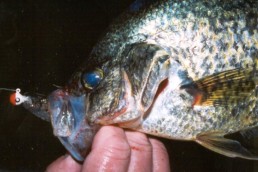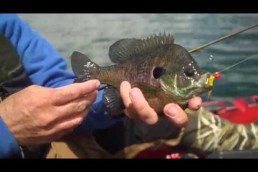Ice Fishing Farm Ponds
SHARE THIS POST
Many of us who grew up in the agricultural Midwest are familiar with farm ponds, since they are very common, and some of us have grown up fishing these waters. Farm ponds are found in much of Wisconsin, Illinois, Iowa, Minnesota, Indiana and Michigan. Many of these ponds are natural, having been formed by underground springs. Others have been dredged or dug by landowners to supply water for livestock, or for their own recreation.
Some of the best ways to find these ponds are to: 1) drive around the countryside, looking for ponds; 2) get a topographical map of the area you would like to fish, and explore the area after looking at the map; 3) talk to landowners and farmers, asking if they have a pond or know of one in the area; and 4) talk to other anglers who are familiar with the area. The best way, I believe, is to get some topo maps and start exploring.
The best time to look for and find these ponds is to start looking in the summer. You’ll find landowners and farmers who might not let you fish during the summer or hunting seasons, but will let you fish in the winter. Often, these ponds are reserved for family members and friends during the open-water fishing seasons. Other landowners don’t care how many fish you keep, but I’d offer them some cleaned fish if you had a good day.
I have a friend who is a farmer with a great little five-acre pond full of nice bluegills, sunfish, crappies and a few largemouth bass. Over the years, I’ve helped stock the pond after getting a permit from the WDNR to buy and release fish in the pond. (You always want the children to catch fish and get hooked on the sport of fishing.) Which brings up a point.
Always check with the DNR to see if you need a permit to buy and release the fish in a pond. Most states will require a permit for the pond, so the DNR knows what is being put in the state’s waters. Also, check for state stocking regulations. With the influx of exotic species these days, the state must have some control of what is being put in its waters.
Are you enjoying this post?
You can be among the first to get the latest info on where to go, what to use and how to use it!
Buying small minnows from wholesalers and fish farmers is the quickest and easiest way to stock a pond with food. I stock one pond with 3- to 5-inch bluegills and crappies for some children’s events I run; the fish are inexpensive, and have done well. I make sure that an abundant supply of forage is also added to the pond so there is plenty of food for the growing fish. The pond has been stocked every other year for five years, and there are now 10- to 12-inch crappies and 7- to 8-inch bluegills. Most of the fish caught are released, and the number taken to eat is minimal.
If you have a pond, or access to one, be sure and drill your holes first, so that you won’t spook the fish with continual drilling during your fishing time. Hop from hole to hole until you find a hot one. It’s nice to bring a flasher with so you can map out the pond, and know what you have for depth and structure. Are there trees, wood, or brush in the pond or around it? If so, then this is good structure.
Looking for farm ponds is something you can do year-‘round. When hunting or walking in the woods, remember where you saw those ponds. These ponds can also be great for duck hunting.
If you find a pond to fish, or get permission to fish one, try these simple techniques: Use a 2- to 4-test line with a small ice fishing jig baited with a waxworm or two, fished on a two-foot sensitive rod. Use a spring bobber to detect light biters. Dress the jig with a couple of waxies. Carry a good assortment of jigs in different colors, and keep changing jigs ‘til you find one that works. If you have water that is over 8 to 10 feet deep, add a small split shot to the line to help get your bait down to the fish. Use different jigging cadences ‘til you find what the fish prefer on that particular day.
MWO
SHARE THIS POST
Did you enjoy this post?
You can be among the first to get the latest info on where to go, what to use and how to use it!
Gary Engberg
If you have any questions or comments you may reach Gary Engberg at 608-795-4208 or garyengbergoutdoors.com.



